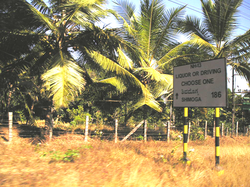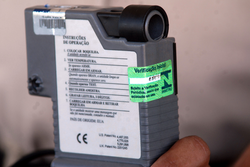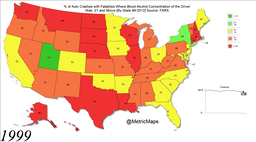Driving under the influence
Driving under the influence

Warning of the dangers of driving and drinking in Himachal Pradesh, India
Driving under the influence (DUI), driving while impaired / driving while intoxicated (DWI), or drink-driving (UK) is currently the crime or offense of driving or operating a motor vehicle while impaired by alcohol or other drugs (including recreational drugs and those prescribed by physicians), to a level that renders the driver incapable of operating a motor vehicle safely. [undefined] People who receive multiple DUI offenses are often people struggling with alcoholism or alcohol dependence.
Traffic accidents are predominantly caused by driving under the influence; for people in Europe between the age of 15 and 29, DUI is one of the main causes of mortality.
[undefined] According to the National Highway Traffic Safety Administration alcohol-related crashes cause approximately $37 billion in damages annually.
[undefined] DUI and alcohol-related crashes produce an estimated $45 billion in damages every year.
Between attorney fees, fines, court fees, ignition interlock devices, and DMV fees a DUI charge could cost thousands to tens of thousands of dollars.
With alcohol consumption, a drunk driver's level of intoxication is typically determined by a measurement of blood alcohol content or BAC; but this can also be expressed as a breath test measurement, often referred to as a BrAC. A BAC or BrAC measurement in excess of the specific threshold level, such as 0.08%, defines the criminal offense with no need to prove impairment. [undefined] In some jurisdictions, there is an aggravated category of the offense at a higher BAC level, such as 0.12%, 0.15% or 0.25%. In many jurisdictions, police officers can conduct field tests of suspects to look for signs of intoxication. The US state of Colorado has a maximum blood content of THC for drivers who have consumed cannabis.
In most countries, sobriety checkpoints (roadblocks of police cars where drivers are checked), driver's licence suspensions, fines and prison sentences for DUI offenders are used as a deterrent. Anyone who is convicted of driving while under the influence of alcohol or other drugs can be heavily fined or given a prison sentence. In some jurisdictions, impaired drivers who injure or kill another person while driving may face heavier penalties. In addition, many countries have prevention campaigns that use advertising to make people aware of the danger of driving while impaired and the potential fines and criminal charges, discourage impaired driving, and encourage drivers to take taxis or public transport home after using alcohol or drugs. In some jurisdictions, the bar that served an impaired driver may face civil liability. In some countries, non-profit advocacy organizations, a well-known example being Mothers Against Drunk Driving (MADD) run their own publicity campaigns against drunk driving.
Terminology
The name of the offense varies from jurisdiction to jurisdiction and from legal to colloquial terminology.
In the USA, the specific criminal offense is usually called driving under the influence (DUI), but in some states "driving while intoxicated" (DWI), "operating while impaired" (OWI), or "operating a vehicle under the influence" (OVI).
Such laws may also apply to boating or piloting aircraft.
Vehicles can include farm machinery and horse-drawn carriages.
Other commonly used terms to describe these offenses include drinking and driving, drunk driving, drunken driving, impaired driving, operating under the influence, or "over the prescribed limit".
In the United Kingdom, the offense is often known as "drunk in charge of a motor vehicle" or "drunk in charge" due to the wording of the Licensing Act 1872. In relation to motor vehicles, the Road Traffic Act 1988 creates a narrower offense of driving (or being in charge of) a vehicle while having breath, blood or urine alcohol levels above the prescribed limits (colloquially called "being over the limit"); and a broader offense of "driving while unfit through drink or drugs", which can apply even with levels below the limits. A separate offense in the 1988 Act applies to bicycles. While the 1872 Act is mostly superseded, the offense of being "drunk while in charge... of any carriage, horse, cattle, or steam engine" is still in force; "carriage" has sometimes been interpreted as including mobility scooters.
Definition
The criminal offense may not involve actual driving of the vehicle, but rather may broadly include being physically in control of a car while intoxicated even if the person charged is not driving.
[undefined] [undefined] For example, a person found in the driver's seat of a car while intoxicated and holding the keys, even while parked, may be charged with DUI, because he or she is in control of the vehicle. In construing the terms DUI, DWI, OWI and OVI, some states therefore make it illegal to drive a motor vehicle while under the influence or driving while intoxicated while others indicate that it is illegal to operate a motor vehicle. There is a split of authority across the country regarding this issue. Some states permit enforcement of DUI/DWI and OWI/OVI statutes based on "operation and control" of a vehicle, while others require actual "driving". "The distinction between these two terms is material, for it is generally held that the word 'drive,' as used in statutes of this kind, usually denotes movement of the vehicle in some direction, whereas the word 'operate' has a broader meaning so as to include not only the motion of the vehicle, but also acts which engage the machinery of the vehicle that, alone or in sequence, will set in motion the motive power of the vehicle." (State v. Graves (1977) 269 S.C. 356 [237 S.E.2d 584, 586-588, 586. fn. 8].
Merriam Webster's Dictionary [undefined] defines DUI as the "crime of driving a vehicle while drunk; also : a person who is arrested for driving a vehicle while drunk; the act or crime of driving while affected by alcohol or drugs; a person who is arrested for or convicted of driving under the influence or an arrest or conviction for driving under the influence. In some countries (including Australia and many jurisdictions throughout the United States), a person can be charged with a criminal offense for riding a bike, skateboard, or horse while intoxicated or under the influence of alcohol. [undefined] [undefined] [undefined]
Alcohol
Blood alcohol content
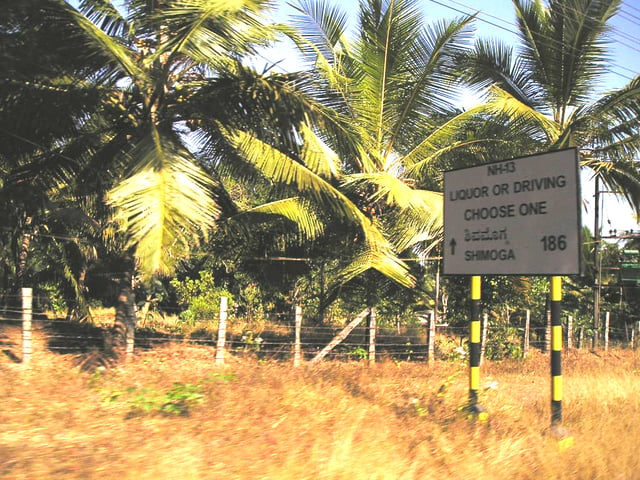
Road sign discouraging drinking and driving in Karnataka, India
Drinking enough alcohol to cause a blood alcohol concentration (BAC) of 0.03–0.12% typically causes a flushed, red appearance in the face and impaired judgment and fine muscle coordination. A BAC of 0.09% to 0.25% causes lethargy, sedation, balance problems and blurred vision. A BAC from 0.18% to 0.30% causes profound confusion, impaired speech (e.g., slurred speech), staggering, dizziness and vomiting. A BAC from 0.25% to 0.40% causes stupor, unconsciousness, anterograde amnesia, vomiting and respiratory depression (potentially life-threatening). A BAC from 0.35% to 0.80% causes a coma (unconsciousness), life-threatening respiratory depression and possibly fatal alcohol poisoning.
A breathalyzer is a device for estimating BAC from a breath sample. It was developed by inventor Robert Frank Borkenstein and registered as a trademark in 1954, but many people use the term to refer to any generic device for estimating blood alcohol content. [undefined] With the advent of a scientific test for BAC, law enforcement regimes moved from sobriety tests (e.g., asking the suspect to stand on one leg) to having more than a prescribed amount of blood alcohol content while driving. However, this does not preclude the simultaneous existence and use of the older subjective tests in which police officers measure the intoxication of the suspect by asking them to do certain activities or by examining their eyes and responses. BAC is most conveniently measured as a simple percent of alcohol in the blood by weight. [undefined] Research shows an exponential increase of the relative risk for a crash with a linear increase of BAC as shown in the illustration. BAC does not depend on any units of measurement. In Europe it is usually expressed as milligrams of alcohol per 100 milliliters of blood. However, 100 milliliters of blood weighs essentially the same as 100 milliliters of water, which weighs precisely 100 grams. Thus, for all practical purposes, this is the same as the simple dimensionless BAC measured as a percent. The per mille (promille) measurement, which is equal to ten times the percentage value, is used in Denmark, Germany, Finland, Norway and Sweden. [undefined]
Depending on the jurisdiction, BAC may be measured by police using three methods – blood, breath, or urine.
For law enforcement purposes, breath is the preferred method, since results are available almost instantaneously.
The validity of the testing equipment/methods and mathematical relationships for the measurement of breath and blood alcohol have been criticized.
[undefined] Improper testing and equipment calibration is often used in defense of a DUI or DWI.
There have been cases in Canada where officers have come upon a suspect who is unconscious after an accident and officers have taken a blood sample.
Driving while consuming alcohol may be illegal within a jurisdiction.
In some it is illegal for an open container of an alcoholic beverage to be in the passenger compartment of a motor vehicle or in some specific area of that compartment. There have been cases of drivers being convicted of a DUI when they were not observed driving after being proven in court they had been driving while under the influence. [undefined] [undefined]
In the case of an accident, car insurance may be automatically declared invalid for the intoxicated driver, i.e. the drunk driver is fully responsible for damages. In the American system, a citation for driving under the influence also causes a major increase in car insurance premiums. [undefined]
The German model serves to reduce the number of accidents by identifying unfit drivers and removing them from until their fitness to drive has been established again.
The Medical Psychological Assessment (MPA) works for a prognosis of the fitness for drive in future, has an interdisciplinary basic approach and offers the chance of individual rehabilitation to the offender. [undefined]
George Smith, a London Taxi cab driver, ended up being the first person to be convicted of driving while intoxicated, on September 10, 1897. He was fined 25 shillings, which is equivalent to £130 in 2016. [undefined]
Risks
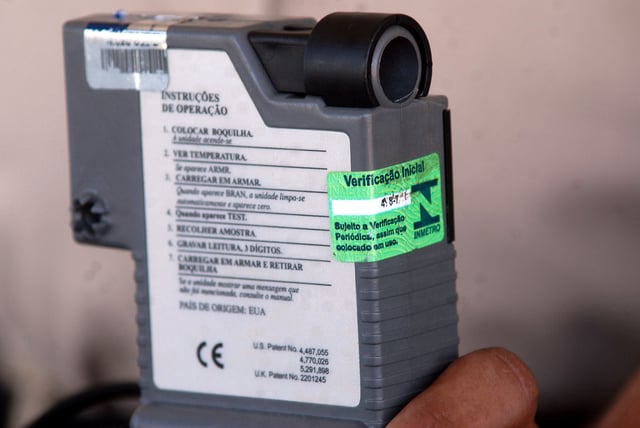
A law enforcement grade Breathalyzer, specifically an Alco-Sensor IV
Studies show that a high BAC increases the risk of accidents whereas it is not clear if a BAC of 0.01–0.05% slightly increases or decreases the risk.
[undefined] One study suggests that already a BAC of 0.04–0.05% would slightly increase the risk whereas some studies suggest that a BAC of 0.01–0.04% would slightly lower the risk, possibly due to the drivers being more cautious.
Both the influential study by Borkenstein et al. and the empirical German data on the 1990s demonstrated that the risk of accident is lower or the same for drivers with a BAC of 0.04% or less than for drivers with a BAC of 0%.
For a BAC of 0.15% the risk is 25-fold.
The 0.05% BAC limit in Germany (since 1998, 0.08% since 1973) and the limits in many other countries were set based on the study by Borkenstein et al. [undefined]
Würzburg University researchers showed that all extra accidents caused by alcohol were due to at least 0.06% BAC, 96% of them due to BAC above 0.08%, and 79% due to BAC above 0.12%. In their study based on the 1990s German data, the effect of alcohol was higher for almost all BAC levels than in Borkenstein et al. [undefined]
In the Blomberg et al. study the crash statistics indicated a lowered risk for BACs 0.01% to 0.04% (87–92% of the risk of a sober driver).
When adjusted for the demographic variables, already at 0.05% BAC the risk seemed to be slightly higher than for the same drivers in 0% although less than for average 0% drivers.
After this adjustment, the lower risk at BAC 0.01–0.03% (92–94%) was not significant.
When also the estimated selection bias was corrected, the risk for these drivers was estimated to be 3-6% higher than for sober drivers, although the difference was not significant.
In Alsop's Grand Rapids study the accident risk at BAC 0.01–0.03% was just 80–96% of that of sober drivers.
[undefined] Also in the Grand Rapids study by Alsop, 0.01–0.03% BAC lead to a crash risk that was 80–96% of the risk of a sober driver, possibly due to extra caution.
Traffic accidents are predominantly caused by driving under the influence for people in Europe between the age of 15 and 29, it is one of the main causes of mortality.
[undefined] According to the National Highway Traffic Safety Administration alcohol-related crashes cause approximately $37 billion in damages annually.
[undefined] Every 51 minutes someone dies from an alcohol-related crash.
When it comes to risk-taking there is a larger male to female ratio as personality traits, antisociality and risk-taking are taken into consideration as they all are involved in DUI's.
Over 7.7 million underage people ages 12-20 claim to drink alcohol, and on average, for every 100,000 underage Americans, 1.2 died in drunk-driving traffic accidents..
Other drugs
For drivers suspected of drug-impaired driving, drug testing screens are typically performed in scientific laboratories so that the results will be admissible in evidence at trial. Due to the overwhelming number of impairing substances that are not alcohol, drugs are classified into different categories for detection purposes. Drug impaired drivers still show impairment during the battery of standardized field sobriety tests, but there are additional tests to help detect drug impaired driving.
The Drug Evaluation and Classification program is designed to detect a drug impaired driver and classify the categories of drugs present in his or her system.
The DEC program breaks down detection into a twelve-step process that a government-certified Drug Recognition Expert (DRE) can use to determine the category or categories of drugs that a suspect is impaired by.
The twelve steps are:
Breath Alcohol Test
Interview with arresting officer (who notes slurred speech, alcohol on breath, etc.)
Preliminary evaluation
Evaluation of the eyes
Psychomotor tests
Vital signs
Dark room examinations
Muscle tone
Injection sites (for injection of heroin or other drugs)
Interrogation of suspect
Opinion of the evaluator
Toxicological examination
DREs are qualified to offer expert testimony in court that pertains to impaired driving on drugs.
The use of the twelve step process is scientifically validated by numerous field studies.
Recreational drugs
Drivers who have smoked or otherwise consumed cannabis products such as marijuana or hashish can be charged and convicted of impaired driving in some jurisdictions. A 2011 study in the B.C. Medical Journal stated that there "...is clear evidence that cannabis, like alcohol, impairs the psychomotor skills required for safe driving." The study stated that while "[c]annabis-impaired drivers tend to drive more slowly and cautiously than drunk drivers,... evidence shows they are also more likely to cause accidents than drug and alcohol-free drivers". [undefined] In Canada, police forces such as the Royal Canadian Mounted Police have "...specially trained drug recognition and evaluation [DRE] officers... [who] can detect whether or not a driver is drug impaired, by putting suspects through physical examinations and co-ordination tests. [undefined] In 2014, in the Canadian province of Ontario, Bill 31, the Transportation Statue Law Amendment Act, was introduced to the provincial legislature. Bill 31 contains driver's license "...suspensions for those caught driving under the influence of drugs, or a combination of drugs and alcohol. [undefined] Ontario police officers "...use standard field sobriety tests and drug recognition evaluations to determine whether the officer believes the driver is under the influence of drugs." [undefined] In the province of Manitoba, an "...officer can issue a physical coordination test. In B.C., the officer can further order a drug recognition evaluation by an expert, which can be used as evidence of drug use to pursue further charges." [undefined]
In the US state of Colorado, the state government indicates that "[a]ny amount of marijuana consumption puts you at risk of driving impaired."
[undefined] Colorado law states that "drivers with five nanograms of active tetrahydrocannabinol (THC) in their whole blood can be prosecuted for driving under the influence (DUI). However, no matter the level of THC, law enforcement officers base arrests on observed impairment." [undefined] In Colorado, if consumption of marijuana is impairing your ability to drive, "it is illegal for you to be driving, even if that substance is prescribed [by a doctor] or legally acquired." [undefined]
Prescription drugs (DUI-D)
Prescription drugs such as opioids and benzodiazepines often cause side effects such as excessive drowsiness, and, in the case of opioids, nausea.
Other prescription drugs including antiepileptics and antidepressants are now also believed to have the same effect.
[53] In the last ten years, there has been an increase in motor vehicle accidents, and it is believed that the use of impairing prescription drugs has been a major factor.
[53] Workers are expected to notify their employer when prescribed such drugs to minimise the risk of motor vehicle accidents while at work.
If a worker who drives has a health condition which can be treated with opioids, then that person's doctor should be told that driving is a part of the worker's duties and the employer should be told that the worker could be treated with opioids. [undefined] Workers should not use impairing substances while driving or operating heavy machinery like forklift trucks or cranes. [undefined] If the worker is to drive, then the health care provider should not give them opioids. [undefined] If the worker is to take opioids, then their employer should assign them work which is appropriate for their impaired state and not encourage them to use safety sensitive equipment. [undefined]
Field sobriety testing
To attempt to determine whether a suspect is impaired, police officers usually will administer field sobriety tests to determine whether the officer has probable cause to arrest an individual for suspicion of driving under the influence (DUI).
A police officer in the United States must have Probable Cause to make an arrest for driving under the influence. In establishing probable cause for a DUI arrest officers frequently consider the suspect's performance of Standardized Field Sobriety Tests. The National Highway Traffic Safety Administration (NHTSA) developed a system for validating field sobriety tests that led to the creation of the Standardized Field Sobriety Test (SFST) battery of tests. The National Highway Traffic Safety Administration (NHTSA) established a standard battery of three roadside tests that are recommended to be administered in a standardized manner in making this arrest decision. [undefined] There are Non-Standardized Field Sobriety Tests as well; however the Non-Standardized Field Sobriety Tests have not received NHTSA Validation. This is the difference between the "Standardized" and the "Non-Standardized" Field Sobriety Tests. The NHTSA has published numerous training manuals associated with SFSTs. As a result of the NHTSA studies, the Walk-and-Turn test was determined to be 68% accurate in predicting whether a test subject is at or above 0.08%, and the One-Leg Stand Test was determined to be 65% accurate in predicting whether a test subject is at or above 0.08% when the tests are properly administered to people within the study parameters.
The three validated tests by NHTSA are:
The Horizontal Gaze Nystagmus Test, which involves following an object with the eyes (such as a pen or other stimulus) to determine characteristic eye movement reaction to the stimulus
The Walk-and-Turn Test (heel-to-toe in a straight line).
This test is designed to measure a person's ability to follow directions and remember a series of steps while dividing attention between physical and mental tasks.
The One-Leg-Stand Test
Alternative tests, which have not been validated by the NHTSA, include the following:
The Romberg Test, or the Modified-Position-of-Attention Test, (feet together, head back, eyes closed for thirty seconds).
The Finger-to-Nose Test (tip head back, eyes closed, touch the tip of nose with tip of index finger).
The Alphabet Test (recite all or part of the alphabet).
The Finger Count Test (touch each finger of hand to thumb counting with each touch (1, 2, 3, 4, 4, 3, 2, 1)).
The Counting Test (counting backwards from a number ending in a digit other than 5 or 0 and stopping at a number ending in a digit other than 5 or 0.
The series of numbers should be more than 15).
The Preliminary Alcohol Screening Test, PAS Test or PBT, (breathe into a "portable or preliminary breath tester", PAS Test or PBT).
In the US, field sobriety tests are voluntary; however, some states mandate commercial drivers accept preliminary breath tests (PBT).
Refusal to take a preliminary breath test (PBT) in Michigan subjects a non-commercial driver to a "civil infraction" penalty, [undefined] but is not considered to be a refusal under the general "implied consent" law.
[undefined] In some states, the state may present evidence of refusal to take a field sobriety test in court, although this is of questionable probative value in a drunk driving prosecution.
In the recent wake of legalized marijuana, law enforcement has sought a method of breath testing to determine the content of THC present in an individual.
Law enforcement efficiently combats driving under the influence with tools like breathalyzers during field sobriety tests.
Excluding edibles, a THC breathalyzer has the potential to measure how ‘high’ an individual may be at the time.
The legality of marijuana does not entail safety on the road, and accurate methods have become required to determine driver impairment.
A THC breathalyzer could revolutionize roadside sobriety testing for drivers suspected of impairment.
Other charges
In the US state of Colorado, impaired drivers may potentially be charged with child endangerment if they are arrested for DUI with minor children in the vehicle. [undefined]
Laws by country
The laws relating to drunk driving vary between countries or subnational regions (e.g., states or provinces) and varying blood alcohol content is required before a charge or conviction can be made. [undefined]
The specific criminal offense may be called, depending on the jurisdiction, "driving under the influence" [of alcohol or other drugs] (DUI), "driving under the influence of intoxicants" (DUII), "driving while impaired" (DWI), "operating vehicle under the influence of alcohol or other drugs" (OVI), "operating under the influence" (OUI), "operating while intoxicated" (OWI), "operating a motor vehicle while intoxicated" (OMVI), "driving under the combined influence of alcohol or other drugs", "driving under the influence per se" or "drunk in charge" [of a vehicle].
Many such laws apply also to motorcycling, boating, piloting aircraft, use of mobile farm equipment such as tractors and combines, riding horses or driving a horse-drawn vehicle, or bicycling, possibly with different BAC level than driving. In some jurisdictions there are separate charges depending on the vehicle used, such as BWI (bicycling while intoxicated), which may carry a lighter sentence.
Some jurisdictions have multiple levels of BAC for different categories of drivers; for example, the state of California has a general 0.08% BAC limit, a lower limit of 0.04% for commercial operators, and a limit of 0.01% for drivers who are under 21 or on probation for previous DUI offenses. [undefined]
Some jurisdictions have judicial guidelines requiring a mandatory minimum sentence.
DUI convictions may result in multi-year jail terms and other penalties ranging from fines and other financial penalties to forfeiture of one's license plates and vehicle.
In many jurisdictions a judge may also order the installation of an ignition interlock device. Some jurisdictions require that drivers convicted of DUI offenses use special license plates that are easily distinguishable from regular plates. These plates are known in popular parlance as "party plates"[undefined] or "whiskey plates".
Argentina
In Argentina, it is a criminal offence to drive if one's level of alcohol is 0,3% or greater at local/municipal jurisdiction, stopped by a municipal police force and 0,4% if driving on a route or highway and stopped by a State Highway Patrol, Argentina Federal Police, or Argentina Gendarmerie.
At the Cordoba State highways and routes, a zero-tolerance police is enforced by Cordoba State Highway Patrol and it is an offence to drive with an alcohol level greater than 0,00%.
Australia
In Australia it is a criminal offence to drive under the influence of alcohol if one's level of alcohol is.05% or greater.
Australian police utilize random breath testing stations, and any police vehicle can pull over any vehicle at any time to conduct a random breath test.
People found to have excessive alcohol are taken to either a police station or a random breath testing station for further analysis.
Those over.08% will receive an automatic disqualification of their licence and must appear in court.
Each state in Australia has its own laws but in all states it is an offence to drive with a BAC exceeding.05% or greater.
In Queensland a person may be able to apply for a work licence to be able to continue to drive for work purposes during their disqualification.
Canada
The Federal government of Canada has adopted truth in sentencing laws that enforce strict guidelines on sentencing, differing from previous practice where prison time was reduced or suspended after sentencing had been issued.
In Canada, refusal to blow into a blood alcohol testing device provided by a police officer carries the same penalties as being found guilty of drunk driving.
South Korea
In Republic of Korea, it is crime to drive if one's level of alcohol is.05% or greater.
[undefined] Police often operates sobriety checkpoints without notice in advance, and it is criminal offense to refuse sobriety test.
Driving under influence of alcohol result in suspension or disqualification of driver's license.
United Kingdom
In British law it is a criminal offence to be drunk in charge of a motor vehicle. The definition depends on such things as being in or near the vehicle, and having access to a means of starting the vehicle's engine and driving it away (i.e., the keys to a vehicle).
The UK's drug driving laws were amended in 2015.
The changes included a new roadside testing kit, which could detect the presence of cocaine and cannabis in a suspect's saliva; zero tolerance limits for a number of illegal drugs, Limits were also set for certain prescription medications.
The laws, however, did not end the use of the field impairment test, but made them more relevant for determining driver impairment by those drugs that are not now covered by the new legislation, or cannot be identified by the limited use of a device, that currently are only authorised for cannabis and cocaine.
United States

Relative risk of an accident based on blood alcohol levels [undefined]
Under the laws of the United States, it is unlawful to drive a motor vehicle when the ability to do so is materially impaired by the consumption of alcohol or drugs, including prescription medications.
[undefined] For impaired driving charges involving the consumption of alcohol, the blood alcohol level at which impairment is presumed is 0.08, although it is possible to be convicted of impaired driving with a lower blood alcohol level.
For example, the state of California has two basic drunk driving laws with nearly identical criminal penalties: [undefined]
V.C.
Sec. 23152(a) - it is a misdemeanor to drive under the influence of alcohol or drugs.
V.C.
Sec. 23152(b) - it is a misdemeanor to drive with.08% or more of alcohol in one's blood.
Under the first law, you may be convicted of impaired driving based upon your inability to safely operate a motor vehicle, no matter what your blood alcohol level.
Under the second law, it is per se unlawful to drive with a blood alcohol level of.08 or greater.
Repeated impaired driving offenses or an impaired driving incident that results in bodily injury to another may trigger more significant penalties, and potentially trigger a felony charge.
Many states in the US have adopted truth in sentencing laws that enforce strict guidelines on sentencing, differing from previous practice where prison time was reduced or suspended after sentencing had been issued. [undefined]
Prevalence
In the United States, local law enforcement agencies made 1,467,300 arrests nationwide for driving under the influence of alcohol in 1996, compared to 1.9 million such arrests during the peak year in 1983.
[undefined] In 1997 an estimated 513,200 DWI offenders were in prison or jail, down from 593,000 in 1990 and up from 270,100 in 1986. [undefined] In the United States, DUI and alcohol-related crashes produce an estimated $45 billion in damages every year. [undefined] In some US and German studies BAC level 0.01-0.03% predicted a lower crash risk than BAC 0%, [undefined] [undefined] possibly due to extra caution, [undefined] whereas BACs 0.08% or higher seem to be responsible for almost all extra accidents caused by alcohol. [undefined] For a BAC of 0.15% the risk is 25-fold. [undefined]
Implied consent
All U.S. states recognize "implied consent", pursuant to which drivers are deemed to have consented to being tested for intoxication as a condition of their operating motor vehicles on public roadways. [undefined] Implied consent laws may result punishment for those who refuse to cooperate with blood alcohol testing after an arrest for suspected impaired driving, including civil consequences such as a driver's license suspension. [undefined] The State of Kansas found unconstitutional a state law that makes it an additional crime to refuse such a test when no court-ordered warrant for testing exists. [undefined]
Employment policies
Many employers or occupations have their own rules and BAC limits; for example, the United States Federal Railroad Administration has a 0.04% limit for train crew. [undefined] Certain large corporations have their own rules; for example, Union Pacific Railroad has their own BAC limit of 0.02% that, if violated during a random test or a for-cause test—for example, after a traffic accident—can result in termination of employment with no chance of future rehire.
See also
Breathalyzer
DR10, UK police code
Drug–impaired driving
Drunk drivers
Drunk walking
DUI California
DWI court
Fetal alcohol spectrum disorder
Mothers Against Drunk Driving (MADD)
National Motorists Association
Responsible drug use
